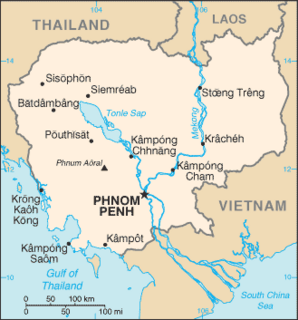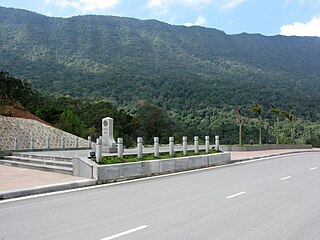
The Ho Chi Minh trail (Vietnamese: Đường mòn Hồ Chí Minh, also called Annamite Range trail was a logistical network of roads and trails that ran from the Democratic Republic of Vietnam to the Republic of Vietnam through the kingdoms of Laos and Cambodia. The system provided support, in the form of manpower and materiel, to the National Front for the Liberation of South Vietnam and the People's Army of Vietnam, or North Vietnamese Army, during the Vietnam War.

The Laotian Civil War (1959–1975) was a civil war in Laos fought between the Communist Pathet Lao and the Royal Lao Government from 23 May 1959 to 2 December 1975. It is associated with the Cambodian Civil War and the Vietnam War, with both sides receiving heavy external support in a proxy war between the global Cold War superpowers. It is called the Secret War among the CIA Special Activities Center and Hmong veterans of the conflict.

Operation Commando Hunt was a covert U.S. Seventh Air Force and U.S. Navy Task Force 77 aerial interdiction campaign that took place during the Vietnam War. The operation began on 15 November 1968 and ended on 29 March 1972. The objective of the campaign was to prevent the transit of People's Army of Vietnam (PAVN) personnel and supplies on the logistical corridor known as the Ho Chi Minh Trail that ran from the southwestern Democratic Republic of Vietnam through the southeastern portion of the Kingdom of Laos and into the Republic of Vietnam.
Operation Igloo White was a covert United States joint military electronic warfare operation conducted from late January 1968 until February 1973, during the Vietnam War. These missions were carried out by the 553d Reconnaissance Wing, a U.S. Air Force unit flying modified EC-121R Warning Star aircraft, and VO-67, a specialized U.S. Navy unit flying highly modified OP-2E Neptune aircraft. This state-of-the-art operation utilized electronic sensors, computers, and communications relay aircraft in an attempt to automate intelligence collection. The system would then assist in the direction of strike aircraft to their targets. The objective of those attacks was the logistical system of the People's Army of Vietnam (PAVN) that snaked through southeastern Laos and was known as the Ho Chi Minh Trail.
Group 559 was a transportation and logistical unit of the People's Army of Vietnam. Established on 19 May 1959 to move troops, weapons, and materiel from North Vietnam to Vietcong paramilitary units in South Vietnam, the unit created and maintained the Ho Chi Minh Trail, the supply line that helped the North win the Vietnam War.

Operation Lam Son 719 or 9th Route – Southern Laos Campaign was a limited-objective offensive campaign conducted in the southeastern portion of the Kingdom of Laos. The campaign was carried out by the armed forces of the South Vietnam between 8 February and 25 March 1971, during the Vietnam War. The United States provided logistical, aerial and artillery support to the operation, but its ground forces were prohibited by law from entering Laotian territory. The objective of the campaign was the disruption of a possible future offensive by the People's Army of Vietnam (PAVN), whose logistical system within Laos was known as the Ho Chi Minh Trail.

Operation Tiger Hound was a covert U.S. 2nd Air Division, later Seventh Air Force and U.S. Navy Task Force 77 aerial interdiction campaign conducted in southeastern Laos from 5 December 1965 till 11 November 1968, during the Vietnam War. The purpose of the operation was to interdict the flow of People's Army of Vietnam (PAVN) supplies on the Ho Chi Minh Trail from the Democratic Republic of Vietnam, through southeastern Laos, and into the northern provinces of the Republic of Vietnam. The missions were originally controlled by the 2d Air Division until that headquarters was superseded by the Seventh Air Force on 1 April 1966.
Operation Barrel Roll was a covert U.S. Air Force 2nd Air Division and U.S. Navy Task Force 77, interdiction and close air support campaign conducted in the Kingdom of Laos between 14 December 1964 and 29 March 1973 concurrent with the Vietnam War.

The Sihanouk Trail was a logistical supply system in Cambodia used by the People's Army of Vietnam (PAVN) and its Viet Cong (VC) guerillas during the Vietnam War (1960–1975). Between 1966 and 1970, this system operated in the same manner and served the same purposes as the much better known Ho Chi Minh Trail which ran through the southeastern portion of the Kingdom of Laos. The name is of American derivation, since the North Vietnamese considered the system integral to the supply route mentioned above. U.S. attempts to interdict this system began in 1969.

Operation Niagara was a U.S. Seventh Air Force close air support campaign carried out from January through March 1968, during the Vietnam War. Its purpose was to serve as an aerial umbrella for the defense of the U.S. Marine Corps Khe Sanh Combat Base on the Khe Sanh Plateau, in western Quang Tri Province of the Republic of Vietnam. The base was under siege by an estimated three-divisional force of the People's Army of Vietnam (PAVN).

The forward air controller (FAC) played a significant part in the Vietnam War from the very start. Largely relegated to airborne duty by the constraints of jungled terrain, FACs began operations as early as 1962. Using makeshift propeller-driven aircraft and inadequate radio nets, they became so essential to air operations that the overall need for FACs would not be completely satisfied until 1969. The FAC's expertise as an air strike controller also made him an intelligence source, munitions expert, communication specialist, and above all, the on-scene commander of the strike forces and the start of any subsequent combat search and rescue if necessary.

The Mụ Giạ Pass is a mountain pass in the Annamite Range between northern Vietnam and Laos, located 90 km northwest of Đồng Hới, Vietnam. The pass is 418 m above sea level and connects National Road 15 from Tân Ấp in Vietnam to Route 12 in Khammouane Province in Laos.
Operation Hardnose was a Central Intelligence Agency-run espionage operation spying upon the Ho Chi Minh trail that began during the Laotian Civil War. Started in Summer 1963, it soon attracted the attention of the U.S. Secretary of Defense, Robert McNamara. By December 1963, he was calling for its expansion. Operation Hardnose expanded and continued to report on the Ho Chi Minh trail even as American military intelligence activities mounted against the communist supply artery. In an attempt to adapt technology for use by illiterate Lao Theung, some of the U.S. Air Force's survival radios were modified by the CIA for use by their spies.
Operation Junction City Jr. was a major Laotian offensive of the Vietnam War; initially aimed at temporary disruption of the Ho Chi Minh Trail, it was extended into an attempt to isolate the major North Vietnamese communist transshipment point at Tchepone from the units it was supposed to supply.
Operation Left Jab was the first military offensive launched against the Sihanouk Trail extension of the Ho Chi Minh Trail during the Second Indochina War. It was the first battalion-sized operation waged by the Royal Lao Army against the communists in Military Region 4. Carried out between 21 and 26 June 1969, the assault interdicted Route 110 of the Sihanouk Trail for its planned three-day stoppage of military supplies. The Royalist guerrillas of Special Guerrilla Unit 2 then evaded an approaching counterattack and regrouped in friendly territory. Operation Left Jab had cleared the way for Operation Diamond Arrow.
Operation Silver Buckle, an offensive staged in Military Region 4 of the Kingdom of Laos, was the deepest Royal Lao Armed Forces penetration to date of the Ho Chi Minh Trail. Reaching the Trailside village of Moung Nong, the forward two companies attacked the rear of the 50,000 People's Army of Vietnam (PAVN) garrison on 8 February 1971, just as Operation Lam Son 719 was launched by the Army of the Republic of Vietnam (ARVN). Overrun and scattered while suffering serious casualties, the Groupement Mobile 30 irregular regiment of Silver Buckle had tied up at least six PAVN battalions, preventing them from opposing Lam Son 719.
Operation Desert Rat was a diversionary attack by a Laotian irregular regiment upon the crucial communist supply line, the Ho Chi Minh trail. Carried out by the Central Intelligence Agency sponsored Groupement Mobile 33, the Desert Rat offensive struck the rear of the 50,000 North Vietnamese troops combating Operation Lam Son 719 beginning on 16 February 1971. With 16 daily tactical air sorties and airborne forward air controllers available, the Desert Rat guerrillas used their hilltop position near Moung Phine to spot targets for bombing. It also raided, skirmishing 110 times, killing 121 communist soldiers, and sowing 1,500 mines along North Vietnamese lines of communication. On 20 March, it was assaulted by two communist battalions. The major threat of Lam Son 719 ended, leaving the communists free to deal with the minor one of Desert Rat. However, the guerrillas split into three columns and exfiltrated by 3 April 1971. The Royal Lao Government had lost control of the strategic Bolovens Plateau to the communist invaders.
Operation Phiboonpol was a "short but very intense engagement" of the Laotian Civil War. Five Royal Lao Government battalions went on the offensive in Military Region 4 of the Kingdom of Laos to try to regain the Boloven Plateau, which overlooked the vital Ho Chi Minh Trail lying to its east. Stopped in its tracks by the People's Army of Vietnam, with its first use of tanks in southern Laos, the Royalists held firm while close air support inflicted heavy casualties on North Vietnamese attackers. A Thai mercenary company sent as a Royalist relief force was ambushed and wiped out. For weeks after the battle, vultures feasted on unburied corpses.
Operation Thao La was a Royal Lao Government (RLG) dry season offensive during the Laotian Civil War, aimed at severing the Ho Chi Minh Trail and retrieving the Lao Bolaven Plateau from the grip of the People's Army of Vietnam. Its objectives were the use of recently captured Salavan as a jumpoff point for occupying Tha Theng and Ban Phong. Key to the plan was a prearranged daily allotment of supportive tactical air power.
Campaign 972 was the final offensive in the south of the Kingdom of Laos by the People's Army of Vietnam (PAVN). After fending off a score of Royal Lao Government attacks against the Ho Chi Minh Trail between June 1969 and late 1972, the PAVN attacked and essentially cut Laos in two at Khong Sedone by November 1972. Sporadic ongoing fighting, especially for control of Paksong, continued until 8 February 1973. Although a ceasefire officially ended the Laotian Civil War at noon on 23 February with Salavan, Thakhek, and Lao Ngam in Communist hands, the PAVN launched another successful assault on Paksong 15 minutes later.









